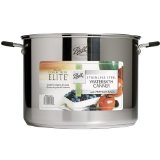Why does everyone say never use an aluminium pot when dyeing?
Name: Christine
—ADVERTISEMENTS—
A 33-quart or 21-quart stainless steel or enamel canning pot will work safely with any sort of fabric dye.

Ball Jar Collection Elite Stainless-Steel 21-Quart Waterbath Canner with Rack and Glass Lid

Columbian Home 33-Quart Jar Canner and Rack
Country or region: U.K.
Message: I want to try dyeing an acrylic yarn with disperse dyes. I bought a large electric soup pot that boils. The only problem is I think the lining of the pot is aluminium. What do you think might or will happen if I use this pot to dye with? Also, why does every one say never use an aluminium pot when dyeing?
Aluminum reacts with both acids, such as vinegar, and bases, such as soda ash or baking soda. You should never use an aluminum pot for any dyeing recipe that calls for either an acid or a base as an auxiliary chemical. (Don't cook vinegar-containing food in aluminum cookware, either, as it will spoil the cookware and give the food an unwanted metallic taste.) This means that an aluminum pot is not very versatile as a dyeing pot, as it can't be used with acid dyes for wool, nor with reactive dyes for cotton and linen. Both the soda ash used with reactive dyes, and the acids used with acid dyes, will dissolve part of the metal into your dyebath, interacting with the dye as a mordant, whether you want it to or not, and leaving permanent etching on the inside of the pot. However, it can be used for those few dyes that can be applied with neither an acid nor a base, including the disperse dyes you are interested in using.
Employees of Jacquard Products have on occasion said that you can use an aluminum, enamel, or stainless steel pot for dyeing with their disperse dye, iDye Poly. The package instructions now say to use enamel or stainless steel, but at one time included aluminum among the options. Although the small number of aluminum ions liberated at a neutral pH might affect the color of some dyes, the effect is far milder than the effect of other metal ions, such as copper, tin, or iron, and is apparently not a big problem for any of the dyes in the iDye Poly line.
Other brands of disperse dye may be preferable, if you can get them, because there are more colors available. The recipes provided for use with those dyes may include an acid or a base, though they should be able to work with the same recipes as the Jacquard brand of disperse dye. Be sure to read ProChem's instructions for "Immersion Dyeing Acrylic using PROsperse Disperse Dyes". [PDF]
I don't know whether your results will be as good if you leave out the citric acid or vinegar they call for, but chances are probably pretty good since there are other recipes elsewhere that don't call for it. Aljo Mfg's instructions for using their "Acetate - Nylon" range of disperse dyes on acrylic do not call for any acid or base at all. See the Aljo Mfg web site; here is a direct link to the directions.
Dyeing acrylic with disperse dye is more pleasant than dyeing polyester, because you don't need the dye carrier additive that smells so bad. Jacquard Products includes this as a separate packet within the package of iDye Poly; other brands offer it as a separate auxiliary chemical. It's completely unnecessary to use the dye carrier when dyeing acrylic, as the dye carrier is useful only for polyester. You will not be able to get an intense dark color on acrylic with disperse dyes, with or without the dye carrier, but the dyes are less toxic than other dyes for acrylic, and far more effective than any dye intended for use on natural fibers.
A general rule about choosing pots for dyeing is that you should never plan to reuse them for food. Unless you're using only food coloring (which makes a surprisingly good dye on wool but does not work at all on cotton or synthetics), you should assume that a dye is toxic and possibly carcinogenic. Dyes that are perfectly safe to use with normal safety precautions are considered unsafe to use in food preparation containers, in case some trace of a chemical, that is eventually found to be moderately carcinogenic or otherwise toxic, later turns out to have been in the dye. This is why dyers prefer to have an all-purpose dyeing pot that can be used for any sort of dye, but that will not be returned to the use of cooking food.
For more information about choosing a dyeing pot, see the following two articles:
(Please help support this web site. Thank you.)
Posted: Thursday - October 20, 2011 at 06:40 AM
Follow this blog on twitter here.
Quick Links
- All About Dyes & Dyeing Top -
- Top of this blog -
- FAQ -
- The Dye Forum -
- How to Tie Dye - How to Batik -
- Books - Toys - Plants -
- Top of this blog -
- FAQ -
- The Dye Forum -
- How to Tie Dye - How to Batik -
- Books - Toys - Plants -
More in this category:
- -
Statistics
Total entries in this blog:
Total entries in this category:
Published On: Aug 29, 2012 02:49 PM
Total entries in this category:
Published On: Aug 29, 2012 02:49 PM